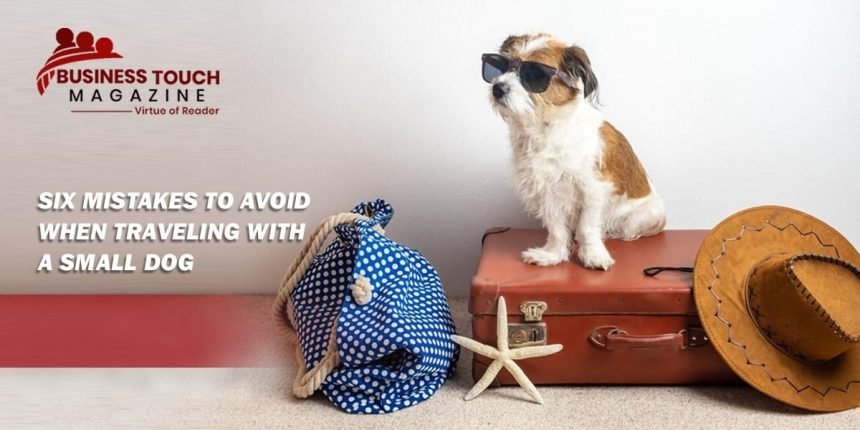Of tandem with the uptick in canine parents, there has been a corresponding increase in the number of individuals who have never taken their pooch on a plane before. Over 23 million homes in the United States (almost one in five) got a pet during the pandemic, says the American Society for the Prevention of Cruelty to Animals (ASPCA). And 37% of pet owners take their animals along on vacation, up from 19% a decade earlier. Over two million pets fly annually, according to the US Department of Transportation.
There has been a dramatic recovery in the demand for travel since the epidemic, and these numbers are expected to continue to rise steadily. Many canines are already experiencing their first flights in aeroplanes in addition to the more common automobile journeys. While it may sound romantic to stroll with your dog through a Parisian café or the Jardin du Luxembourg, there are significant risks involved if you do not prepare beforehand. Your dog may have experienced some anxiety or trauma throughout the travel, even if it makes it to its final destination unscathed.
The only size of dog allowed in an aeroplane cabin is a little one, unless it is a service dog. Those that exceed the airline’s carry-on weight limit (often between 16 and 20 pounds) must be transported as shipping cargo or checked baggage in the aircraft’s cargo hold. Animal protection groups like the Humane Society and PETA warn against transporting your dog in the cargo hold due to the excessive heat or cold, the lack of air, the physical handling, and the lack of surveillance. Therefore, staying inside the plane is always the best option.
If you’ve never travelled with a small dog before, you should know better than to make these six rookie blunders on your next trip, whether it’s a weekend break or a trip across the world.
1. Not investing enough time into carrier training
If you want to take your tiny dog on a plane with you, carrier training is a must. In preparation for a flight, you should do everything you can to make your pet feel at ease and secure while inside the carrier. This is an essential yet time-consuming and treat-intensive process. Before taking your pet on its first long-distance international journey, you should spend at least two to three months teaching it to ride in the carrier on a daily basis; for a local flight, you should spend at least a month doing the same. Without proper preparation, the journey might be stressful for the animal.
Maintaining a routine of daily practise is essential for achieving any goal. For the three months leading up to Roger W.’s first international journey to Paris, I devoted at least 20 minutes every day to making the airline the most thrilling place on earth. I enticed him into the carrier by placing some of his favourite snacks and toys inside.
After your dog willingly enters the carrier three or four times, you may begin locking it up gradually. At first, let it explore the carrier for a few minutes each day. Make sure to put in extra time in training every day if you want to turn your carrier into a fortress. The minimum amount of time your pet should spend in the carrier before the journey begins is one to three hours. Your dog will fare better on the flight if it is comfortable while inside the carrier.
2. Not researching the return flight requirements
People who want to take their dogs on a foreign trip often just perform one-way research, such as how to transport their dog to Paris or Rome. Until it is almost time for their return journey, they do not undertake any preparation.
Unless you’re leaving the country permanently, you’ll need to research the specific criteria for bringing your dog back into the US. There might be more prerequisites set by the state you are visiting.
3. Making your dog’s first flight an international one
Your small furry friend will have just as much trouble as the rest of us on a long journey. No matter how confident you are in your tiny dog’s ability to traverse the globe, you should never take it on a long-haul international journey for the very first time. You should give your dog at least one flight inside the country before taking it internationally. Before committing to the 10-plus-hour travel from Los Angeles to Paris, I flew Roger W. four times between San Francisco and Los Angeles (and returned) and between California and New York City.
Dogs, unlike people, have no clue where they’re going or how long they’ll be stuck on the aircraft. So, the better off your tiny dog will be on the big (long) trip day if you can get it used to flying in the days leading up to it, and not only on the day of departure.
4. Booking a flight with more than one layover
There may be times when you want to save money by booking a flight with several stops, but if you’re travelling with a small dog, it’s best to avoid doing so. Once again, they have no idea of their destination or the time required to get there. Your dog’s delicate body will feel the effects of the lengthy journey much more during a stopover, no matter how little it may seem to you. If you have to make many stops because of layovers, you should stay in the layover location for a few days to a week before continuing on to your final destination.
5. Not exhausting your dog’s energy
The best way to ensure your pet sleeps during the journey is to tyre it out with plenty of activity before takeoff. A dog that is weary is a dog that is content, as the old adage goes. Make it a habit to take a stroll before every flight for a hassle-free, stress-free trip. If you want your dog to sleep during the trip, it will benefit from some additional exercise and playing around 15 to 20 minutes before takeoff. The more of the flight it can spend sleeping, the less turbulent it will be.
Obviously, your dog shouldn’t spend an additional 15 minutes outside in temperatures that low or high, so take its general health and the weather in mind before deciding to prolong the duration.
6. Not being strategic with water and food intake
When it comes to accidents, airline passengers have a very low tolerance for “misbehaving” pets. No one likes to be near a dog, no matter how little, that has just urinated on the floor (the same goes for barking). Therefore, plan meals, drinks, and bathroom breaks ahead of time and throughout the journey to reduce the likelihood of any mishaps. Never take your little dog on a flight if it has just eaten, and always feed it at least two hours before you leave for the airport so that it has time to digest and use the restroom.




